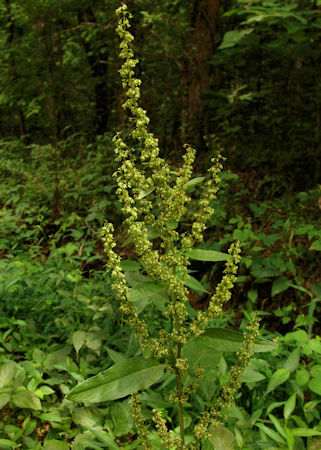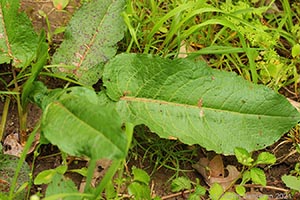Yellow Curly Dock and Bitter Dock
Rumex crispus,
Rumex obtusifolius
Dock Plant Description and Habitat
Curly Dock, Narrow Leaf Dock or Yellow Dock, is a perennial weedy herb commonly found growing wild in waste places, fields, roadsides and pastures all over the United States and Canada, except for desert areas. Dock is also likely to show up in your yard.
The plants are first seen in winter and early spring as a rosette or a few basal leaves poking out of the ground. The bottom leaves grow to 6 - 12 inches long. Note the wavy margin of the leaves characteristic of Curly Dock, that botanical author John Eastman calls “resembling the lolling tongues of dogs.”
Dock flower stalks are usually 2 - 3 feet tall, but may grow as high as 5 feet. The leaves on the flower stalk are much smaller than the basal leaves. Small green flowers emerge clustered on spikes and change to brown later in the season.
Dock has a taproot that is carrot shaped and forked. The roots have a radish-like taste and odor. They can be used to make a yellow dye.


The following information is for educational purposes only and not intended to be used for diganosing, treating, or curing any disease or condition. Please see a physician about health concerns.
Dock Uses in Traditional Herbal Medicine
A tea made of the whole Curly or Yellow Dock plant or just the root has been used in traditional herbal medicine as a tonic for it's nutritional content. Dock has been used throughout the ages as a “blood purifier.” It was believed that its bitters cleansed the liver and eliminated toxins in the body. Dock is a good source for Thiamine, Vitamin C, and Iron.
The leaves have a laxative effect. The yellow root is the part used most in herbal medicine and has been revered historically as a blood cleanser, much like Burdock. The two plants are not related but share many of the same uses.
Dock plants are high in oxalic acid which is problematic for people prone to kidney stones and some other conditions.
A poultice of Dock leaves or mashed root is used for ulcers, burns, skin diseases and was historically used for tumors and swellings. A folk remedy saying, “Nettle in, Dock out,” was once famous as it told that rubbing Dock leaves would instantly ease the burn from Stinging Nettle. As with many plants, it is often used in salves for troubled skin. A mash of the plant has been said to be helpful for skin conditions caused by parasites. Dock seeds are high in antioxidants and can be ground into a bitter flour with little to recommend its use taste-wise, so why not try it for an exfoliating, antioxidant body scrub?

Cautions
External Use : Some people are allergic to a variety of plants and may experience skin irritation from handling them. Safe for most people.
Internal Use Contraindications
Do not use if you are taking blood thinners as dock may have the opposite effect, therefore reducing the effectiveness of the medication.
Dock is very high in Oxalic acid which is found in many foods like spinach and almonds that we don't usually think twice about eating in normal quantities. As with other plants containing oxalic acid, do not use if you have kidney disease or if your doctor tells you not to eat vegetables that contain oxalic acid like spinach. Oxalic acid binds with calcium and can form kidney stones.
Dock Edible Uses
Most people would agree that Rumex is not usually a favored food source due to the bitter taste. However, the whole Dock plant is edible, and loaded with Vitamin A and C as well as Iron, and the seeds are said to have antioxidant properties. The young leaves and stems have a tangy taste like Wood Sorrel.
Young Curly Dock leaves can be cooked as a potherb by boiling for 5 – 10 minutes. Only the smallest leaves are considered palatable to most people as the older leaves are quite bitter. Changing water at once or twice during cooking is recommended to lower the level of oxalic acid (see cautions).
Some people might enjoy the smallest Dock leaves chopped and used as a tangy, sour garnish. They can be eaten raw in small quantities in salads. Dock is considered safe in small amounts.
The Backyard Forester seems to have a high esteem for Dock as a food source.
Learn more about Yellow Curly Dock. External links
Water extract of Rumex crispus prevents bone loss Pubmed
Determination of antioxidant and antimicrobial activities of Rumex crispus L. extracts. Pubmed
Studies on the chemical constituents of Rumex crispus Pubmed
Antimalarial activity of nepodin isolated from Rumex crispus. Pubmed
The Genus Rumex: Review of traditional uses, phytochemistry Herbal Research Study List
Determination of antioxidant and antimicrobial activities of Rumex crispus L. extracts.
From My Herbal Bookcase
My books used to research Dock plants. Links to Amazon Books. I make a small commission from book sales or anything else you might buy going to Amazon from these links.
Nature's Garden: A Guide to Identifying, Harvesting, and Preparing Wild Plants
Thayer, Samuel, March 1, 2010. Forager's Harvest Press.
Great color photos and indentification tips for edible plants. A must have book if you are interested in foraging plants.
The Book of Field and Roadside. Open Country Weeds, Trees and Wildflowers of the Eastern United States
Eastman, John Stackpole, 2003 Only available on Kindle Format. $9.99
The Herb Book by John Lust
Covers almost 500 medicinal plants, including many native species, as well as recipes for many herbal concoctions.
A wealth of information in an inexpensive paperback edition. Not the best illustrations but you can look those up online.
Identifying and Harvesting Edible and Medicinal Plants in Wild (and Not So Wild) Places, Steve Brill: Hearst Books, NY, 1994



